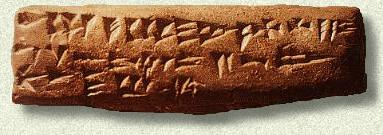The Children of El in Ancient Ugarit
“There is, of course, a logical problem with the twofold reference of the Nephilim to the antediluvian warriors and to the giant inhabitants of Canaan on the eve of the Israelite conquest. The flood intervenes, which kills all living creatures on earth: “Everything with life’s breath in its nostril, everything that lived on dry land, died” (Genesis 7:22 J).
The continuance of the Nephilim contradicts the testimony of the flood story (thus providing a lively subject for post biblical exegetes). The likely solution to this problem is that the writer was heir to traditions about the Nephilim that were not internally consistent, but was constrained by the audience’s horizons of expectations to relate these traditions accurately.
Such internal inconsistency is characteristic of oral traditions in many cultures, and we may point to this particularly inconsistency as a sign of the oral multiformity of the narrative lore of ancient Israel. As with the Sons of God, the Nephilim no doubt populated more stories in ancient Israelite culture than the brief texts that have been preserved.
To gain a richer understanding of Genesis 6:1-4–both of its content and its gaps–it is useful to consider the longer history (the discursive longue durée) of these narrative elements in ancient Near Eastern and Mediterranean cultures. The most immediate cultural context, for this and much else in ancient Israel, is the culture of Canaan from which early Israel emerged.
We have seen above that the term “Sons of God” has a direct antecedent in the Canaanite bn’il, “Sons / Children of El.” This group is referred to several times in Ugaritic literature of the Late Bronze Age and is carried on in several later West Semitic cultures of the Iron Age.

“Ugaritic text“. Licensed under Public Domain via Wikimedia Commons.
In the Ugaritic texts the “Sons / Children of El” are the members of El’s divine assembly (Mark S. Smith, trans., Simon B. Parker, ed., Ugaritic Narrative Poetry, 1997). They are described as the offspring of El and his chief wife, the goddess Asherah. One of El’s epithets is ‘ab bn ‘il, “Father of the Children of El,” indicating his paternity of the gods, and Asherah is called qnyt ‘ilm, “Creatress of the gods.”
The Children of El are often shown feasting in heaven, as is the wont of the gods. At one point Baal recounts an shameful–but obscure–event during a feast in the divine assembly:
“… He stood and abased me.
He arose and spat on me.
Amid the ass[em]bly of the Children of El bn’ilm”
(Manfred Dietrich, Oswald Loretz, and Joaquín Sanmartín. Cuneiform Alphabetic Texts from Ugarit, Ras Íbn Hani and Other Places. (CAT). KTU 2d enlarged edition. Münster: Ugarit-Verlag, 1995, 1.4.iii.12-4)
Usually the gods feast in heaven, but occasionally they attend feasts on earth in the company of humans, such as the wedding feast for King Kirta (CAT 1.15.iii).

A Statuette of Baal.
http://www.american-buddha.com/bible.ugarit.htm
The Children of El are immortal, as the goddess Anat affirms in her (probably spurious) promise of immortality to the mortal hunter Aqhat:
“Ask for life, Aqhat the Hero.
Ask for life, and I’ll give it.
Deathlessness–I’ll endow you.
I’ll let you count years with Baal.
Count months with the Children of El bn’il.”
(CAT 1.17.vi.26-9, after Mark S. Smith, trans., in Parker, ed., Ugaritic Narrative Poetry, 61, and Ronald Hendel, The Epic of the Patriarch: The Jacob Cycle and the Narrative Traditions of Canaan and Israel, 1987, pp. 74-81.)
Though immortal, the Children of El are less powerful than El. In the Kirta epic, El asks the divine assembly seven times if any among them can remove disease, but they are silent. Apparently El alone has the power to heal:
“Stay seated, my children (bny), on your seats.
On your elevated thrones.
As for me, I’ll use skills and create.
I’ll create a remover of illness.
A dispeller of disease.”
(CAT 1.16n.24-8).
Interestingly, this passage appears to equate the Children of El with the stars, comparable to the biblical concept in Job 38:7 and the biblical term “Host of Heaven” (see above).
The Children of El in the Ugaritic texts, cognate to the biblical Sons of God, are subordinate to the high god El, just as the biblical Sons of God are subordinate to Yahweh. They are less powerful than El and they occasionally visit humans on earth. Nowhere in the extant texts, however, do the Children of El engage in sex with humans.
In one curious text, Baal may have sex with a cow, which bears “a bull for Baal” (CAT 1.10.35, see Smith, trans., Parker, ed., Ugaritic Narrative Poetry, 181-7), but there is no other inter-species sex that we can discern.”
Ronald Hendel, “The Nephilim Were on the Earth: Genesis 6:1-4 and its Ancient Near Eastern Context,” in Christoph Auffarth and Loren T. Stuckenbruck, eds., The Fall of the Angels, Brill, 2004, pp. 22-4.

